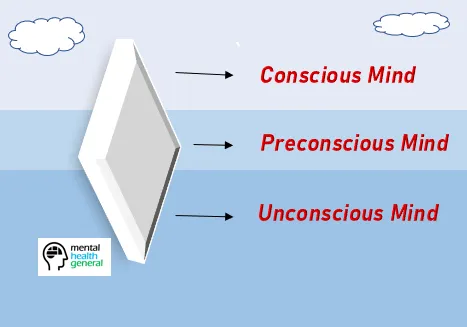
In the field of mental health, there have been several arguments on the nature of the mind, its components, and how it relates to mental illness. Many of history’s greatest thinkers have discussed the mind in depth.
The most well-known theories of the mind in mental health come from Sigmund Freud and Carl Jung. Freud’s theory of the mind is especially well-known.
Both Freud and Jung, along with many other theorists, have proposed the existence of multiple layers of the mind. These include a “Conscious” and “Unconscious” mind. But what is the difference between them?

Freud’s Theory of the Mind
Freud used an iceberg to explain his theory of the mind. When a person sees an iceberg, they can only see what is above the water, and are therefore unaware of what is under the water.
Freud argues that this is like the human mind. A person can only see a small amount, the rest lies underwater. The tip of the iceberg refers to the conscious mind, with the remainder of the iceberg out of view under the water – which refers to the unconscious mind.
One is never truly aware of how much of the iceberg is out of view – the unconscious mind may be very, very deep.
The other area is the middle-ground of the two – and known as the preconscious. It is the part of the iceberg that is mainly submerged below the water, yet still visible from above.
The Conscious Mind
The Conscious Mind refers to the mind we know about, and everything within it. This is the easiest part to understand – as it is simply what we all have. It includes everything we consciously know about.
We use our mind to think and analyse, and decide how to act. But Freud’s theory suggests that the conscious mind does not have all of our thoughts and feelings. Instead, some of these belong in the Unconscious or Preconscious minds.
Through therapy, a person will be able to bring thoughts, memories and other feelings from the unconscious mind to the conscious mind. This can be used when a person is going through mental health problems – which Freud argues is the result of traumas, events and feelings that are stuck in the unconscious or preconscious mind.
The Unconscious Mind
The Unconscious Mind is made up of a range of feelings, thoughts and memories that are outside our immediate conscious. Most of these feelings and memories are negative. For example, they may be traumas, fears, painful feelings or thoughts.
The process of these feelings, thoughts and memories not being in the conscious mind is called Repression. This is where the mind intentionally blocks out certain thoughts, feelings or memories in order to protect itself.
Freud suggests that these areas continue to influence the day-to-day life of a person. This often manifests itself as symptoms of mental illness – like Depression or Anxiety.
But a person isn’t aware of the influence of the unconscious mind – as it is outside of their awareness. Therefore, they may require the use of therapy to try and process the elements bothering them in a positive way.
How can the unconscious become conscious?
Freud suggested that it was possible to reach the unconscious mind through utilising a few different techniques. He proposed that this should be done during therapy sessions. The main techniques he used were:
- Free Word Association: Free word association involves a therapist letting their patient speak freely. The patient is encouraged to talk about whatever is on their mind. In doing so, it provides a therapist with a chance to find consistent themes or patterns, which can lead to the therapist identifying potential issues.
- Dream Analysis: Dream analysis involves the therapist analysing and interpreting the dreams that a person has. Freud believed that dreams are often linked to past experiences being repressed, which allows dreams to offer a view of a person’s unconscious mind.
- Freudian Slips: Freudian Slips are “slips of the tongue” that take place. Freud believed that when someone accidentally said a certain word or phrase, that they secretly meant to say this – and that this was the unconscious mind breaking free. A therapist would therefore pay close attention to everything a person says.
We have an article that explores these techniques in more detail here.
Summary
Freud argues that both the Conscious and Unconscious minds have a strong impact on mental health. Their relationship is important, and effects our overall mental wellbeing and our behaviour, thoughts and feelings.
While it is always important to analyse these theories, the most important thing of all is that anyone who is struggling with their mental health receives help. It is possible to improve mental wellbeing – and it is something we should all strive for.
See Also
- Overview of Sigmund Freud’s Theories
- Freud’s Theory of the Unconscious, Conscious and Preconscious Minds in Mental Health
- What is the Unconscious Mind in Mental Health?
- What is the Preconscious Mind in Mental Health?
- What is the Conscious Mind in Mental Health?
- What is the Difference Between The Unconscious and Conscious Mind in Mental Health?
- How Can You Reach the Unconscious Mind in Mental Health Therapy?
- Homepage
Disclaimer
This website should be used purely for informational purposes, and does not intend to, nor should it ever, be used as a replacement for professional medical advice.
We strive to keep all of our pages updated, and ensure that our website is full of factual and in-depth information. However, we encourage you to browse this website with care.
As a reminder, this website and all content within it cannot and should not replace the advice of a trained medical professional. You can read our full disclaimer at this link.
Helplines
If you are struggling with your mental health, help is available. With the right support and treatment, you can make a recovery. For information on helplines, or if you are in a state of crisis, please visit our crisis page by clicking on the relevant link for your geographical location (United Kingdom), (United States), (International). You can also see how to get mental health treatment and the process involved by clicking this link.

































